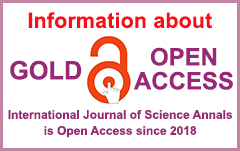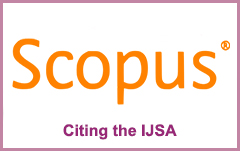| 1 Employees’ State Insurance Corporation Medical College, India |
Abstract
Background and Aim of Study: Decreased efficacy of metered dose inhaler and dry powder inhalers are associated with errors in inhalational techniques.
The aim of the study: to study the association of errors in the technique for using two types of inhalers with demographic and other variables.
Material and Methods: Five hundred adult patients with respiratory diseases who were currently using an inhaler device were enrolled in this study. Patient’s demographics and duration of inhaler therapy and assessment of inhaler technique were recorded by interview and direct observation.
Results: Out of 500 enrolled patients, 465 patients were using the device with wrong technique. Among 465 patients, 188 patients were using metered dose inhaler and 277 patients were using dry powder inhalers. Technical errors were common in both the devices but more common with metered dose inhaler device. Failure to exhale before the inhale through device was most common error with metered dose inhaler (68.6%) and dry powder inhalers (71.4%). Association of errors with female gender is seen in both metered dose inhaler and dry powder inhalers users. Reduction in the numbers of errors is seen with increase in the duration of therapy and regular training on follow-up visits.
Conclusions: Dry powder inhalers and metered dose inhalers are commonly used in management of respiratory patients. Therefore, the errors in using these devices, technique and handling errors are common in both dry powder inhalers and metered dose inhaler users. More error was found in old age, female and short-term users. However regular training on follows up visits can solve this current problem.
Keywords
metered dose inhaler, dry powder inhalers, inhalational technique, technical errors, demographic, respiratory diseases, aerosol therapy
References
Atkins, P. J. (2005). Dry powder inhalers: An overview. Respiratory Care, 50(10), 1304-1312. https://pubmed.ncbi.nlm.nih.gov/16185366/
Castel-Branco, M. M., Fontes, A., & Figueiredo, I. V. (2017). Identification of inhaler technique errors with a routine procedure in Portuguese community pharmacy. Pharmacy Practice, 15(4), 1072. https://doi.org/10.18549/PharmPract.2017.04.1072
Choomuang, W., Pothirat, C., Chaiwong, W., Liwsrisakun, C., Theerakittikul, T., Phetsuk, N., & Chanayat, P. (2022). The effectiveness of large group demonstration training method on the use of pressurized metered-dose inhaler in elderly with chronic obstructive pulmonary disease. Journal of Thoracic Disease, 14(4), 919-926. https://doi.org/10.21037/jtd-21-1612
Chorao, P., Pereira, A. M., & Fonseca, J. A. (2014). Inhaler devices in asthma and COPD – An assessment of inhaler technique and patient preferences. Respiratory Medicine, 108(7), 968-975. https://doi.org/10.1016/j.rmed.2014.04.019
Cochrane, M. G., Bala, M. V., Downs, K. E., Mauskopf, J., & Ben-Joseph, R. H. (2000). Inhaled corticosteroids for asthma therapy: patient compliance, devices, and inhalation technique. Chest, 117(2), 542-550. https://doi.org/10.1378/chest.117.2.542
Crompton, G. K. (1991). Dry powder inhalers: Advantages and limitations. Journal of Aerosol Medicine, 4(3), 151-156. https://doi.org/10.1089/jam.1991.4.151
EBSCO. (2020, November 16). Dynamic health in action: COPD. https://www.ebsco.com/resources/dynamic-health-action-copd
Melani, A. S., Bonavia, M., Cilenti, V., Cinti, C., Lodi, M., Martucci, P., Serra, M., Scichilone, N., Sestini, P., Aliani, M., & Neri, M. (2011). Inhaler mishandling remains common in real life and is associated with reduced disease control. Respiratory Medicine, 105(6), 930-938. https://doi.org/10.1016/j.rmed.2011.01.005
Melani, A. S. (2007). Inhalatory therapy training: A priority challenge for the physician. Acta Bio-Medica: Atenei Parmensis, 78(3), 233-245. https://pubmed.ncbi.nlm.nih.gov/18330086/
Nainwal, N., Sharma, Y., & Jakhmola, V. (2022). Dry powder inhalers of antitubercular drugs. Tuberculosis (Edinburgh, Scotland), 135, 102228. https://doi.org/10.1016/j.tube.2022.102228
Newman, S. P. (2005). Principles of metered-dose inhaler design. Respiratory Care, 50(9), 1177-1190. https://pubmed.ncbi.nlm.nih.gov/16122401
Newman, S. P., Weisz, A. W., Talaee, N., & Clarke, S. (1991). Improvement of drug delivery with a breath actuated pressurised aerosol for patients with poor inhaler technique. Thorax, 46(10), 712-716. https://doi.org/10.1136/thx.46.10.712
Pothirat, C., Chaiwong, W., Phetsuk, N., Pisalthanapuna, S., Chetsadaphan, N., & Choomuang, W. (2015). Evaluating inhaler use technique in COPD patients. International Journal of Chronic Obstructive Pulmonary Disease, 10(1) 1291-1298. https://doi.org/10.2147/COPD.S85681
Prime, D., Atkins, P. J., Slater, A., & Sumby, B. (1997). Review of dry powder inhalers. Advanced Drug Delivery Reviews, 26(1), 51-58. https://doi.org/10.1016/S0169-409X(97)00510-3
Pritchard, J. N., & Giles, R. D. (2014). Opportunities in respiratory drug delivery. Therapeutic Delivery, 5(12), 1261-1273. https://doi.org/10.4155/tde.14.78
Pritchard, J. N. (2015). Industry guidance for the selection of a delivery system for the development of novel respiratory products. Expert Opinion on Drug Delivery, 12(11), 1755-1765. https://doi.org/10.1517/17425247.2015.1056148
Rootmensen, G. N., Van Keimpema, A. R., Jansen, H. M., & de Haan, R. J. (2010). Predictors of incorrect inhalation technique in patients with asthma or COPD: A study using a validated videotaped scoring method. Journal of Aerosol Medicine and Pulmonary Drug Delivery, 23(5), 323-328. https://doi.org/10.1089/jamp.2009.0785
Tsangarides, A. A., Wilkinson, A., & Mir, F. (2018). Disadvantages of salbutamol pressurised metered-dose inhalers (pMDIs). Thorax, 73(Suppl. 4), A193-A194 https://doi.org/10.1136/thorax-2018-212555.327
Usmani, O. S., Lavorini, F., Marshall, J., Dunlop, W. C. N., Heron, L., Farrington, E., & Dekhuijzen, R. (2018). Critical inhaler errors in asthma and COPD: A systematic review of impact on health outcomes. Respiratory Research, 19, 10. https://doi.org/10.1186/s12931-017-0710-y
Virchow, J. C., Crompton, G. K., Dal Negro, R., Pedersen, S., Magnan, A., Seidenberg, J., & Barnes, P. J. (2008). Importance of inhaler devices in the management of airway disease. Respiratory Medicine, 102(1), 10-19. https://doi.org/10.1016/j.rmed.2007.07.031
Chaudhary Kamran – https://orcid.org/0000-0001-6697-2409; MD, Assistant Professor, Department of Pulmonary Medicine, Employees’ State Insurance Corporation Medical College, Faridabad, India.
Kumar Avinash (Corresponding Author) – https://orcid.org/0000-0002-3009-0866;
| |
APA
Chaudhary, K., & Kumar, A. (2023). Inhalation therapy: An analysis of inhalation technique errors in metered-dose inhaler and dry powder inhaler users. International Journal of Science Annals, 6(1), 47–52. https://doi.org/10.26697/ijsa.2023.1.5
Harvard
Chaudhary, K., & Kumar, A. 2023. " Inhalation therapy: An analysis of inhalation technique errors in metered-dose inhaler and dry powder inhaler users". International Journal of Science Annals, [online] 6(1), pp. 47–52. viewed 30 June 2023, https://culturehealth.org/ijsa_archive/ijsa.2023.1.5.pdfVancouver
Chaudhary K., & Kumar A. Inhalation therapy: An analysis of inhalation technique errors in metered-dose inhaler and dry powder inhaler users. International Journal of Science Annals [Internet]. 2023 [cited 30 June 2023]; 6(1): 47–52. Available from: https://culturehealth.org/ijsa_archive/ijsa.2023.1.5.pdf https://doi.org/10.26697/ijsa.2023.1.5











